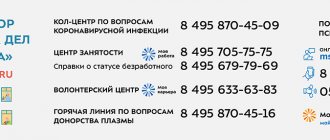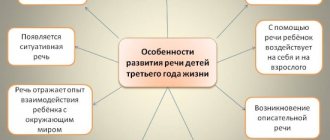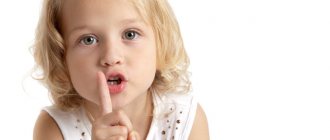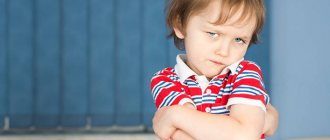Dysarthria - symptoms and treatment
The following forms of dysarthria are distinguished depending on the damage to brain structures [9].
Bulbar dysarthria is a consequence of damage to the bulbar group of cranial nerves: glossopharyngeal, vagus and hypoglossal. Characterized by weakness of articulation muscles, decreased muscle tone. As a result, speech is slurred, extremely slow, and the face is depleted of facial expressions.
Subcortical dysarthria occurs with lesions of the subcortical nodes of the brain. It is distinguished by the presence of hyperkinesis - violent facial movements uncontrollable by the child. Muscle tone changes from normal to increased. The tempo-rhythmic organization of speech suffers.
Cerebellar dysarthria is observed when the cerebellum or its connections with other structures of the nervous system are damaged. It is distinguished by scanned, “chopped” speech. There is no smooth transition from one word to another.
Cortical dysarthria , as the name suggests, is associated with damage to the cerebral cortex, namely, the lower part of the anterior central gyrus of one or both hemispheres. Also, cortical dysarthria is diagnosed when the dominant hemisphere is damaged (for right-handers - left, for left-handers - right) in the lower postcentral parts of the cortex. Children with this form are good at mastering isolated pronunciation of sounds, but have great difficulty using them in the flow of speech, and sometimes skip them altogether.
Pseudobulbar dysarthria is noted with bilateral damage to the motor corticonuclear tracts connecting the nuclei of the cranial nerves of the brain stem with the cortex. Characterized by the inability to organize clear rhythmic movements. In early childhood, such a child often chokes and has difficulty chewing; at an older age, a number of speech problems are discovered due to poor mobility of the articulatory muscles; speech is extremely slurred.
There are several degrees of dysarthria [6]:
First degree. Most often they talk about erased dysarthria; in this case, defects in sound pronunciation may be barely noticeable to others. They are identified by a speech therapist and, when corrected, are particularly resistant, which means that a lot of time and effort will have to be spent. As a rule, such children are seen by a neurologist at 1-2 years of age, but thanks to the plasticity of the child’s nervous system, many symptoms are compensated for by 4-5 years, and the child “outgrows” them. An unpleasant surprise is persistent problems with sound pronunciation in preschool age.
Second degree. Defects in sound pronunciation are very noticeable to others, but overall speech remains understandable. Along with speech symptoms, psychological symptoms are also observed. Often there is a deficiency of fine and gross motor skills, some clumsiness, behavioral disorder, emotional-volitional disorder, attention deficit disorder, hyperactivity, etc.
Children with the first and second degrees of dysarthria, as a rule, have fairly intact thinking.
Third degree. Understanding the speech of a dysarthric child is difficult for others. It is often not clear what the child is saying. Non-speech symptoms are extremely pronounced. A critical level of speech underdevelopment has the most negative impact on the behavior and thought processes of the child. We can talk about disruption of almost all mental functions: memory, attention, thinking, emotional-volitional sphere, etc.
The fourth is the most severe degree. Speech is almost always incomprehensible even to the closest people or is absent altogether.
You can count on complete correction of sounds in speech with the first and second degrees. The third and fourth degrees are diagnosed for severe lesions, for example, in children with cerebral palsy (CP), the prognosis for correction here is less optimistic.
What forms of the disease are observed
Considering the level of distribution of damage to speech function, bulbar, pseudobulbar, extrapyramidal, cerebellar, and cortical forms are distinguished. The formation of the prosodic component of speech in dysarthria occurs through singing, during which it is necessary to change the strength of the voice and intonation. Exercise, breathing and pronunciation exercises are of no small importance when correcting voice pathologies.
The complex of effects of speech therapy classes for dysarthria allows you to:
- develop the articulatory apparatus,
- develop your voice (timbre, strength, pitch, range),
- develop breathing (depth and duration of inhalation and exhalation).
Timely commencement of speech therapy work for dysarthria in preschool children on an ongoing basis will lead to rapid correction of speech function.
Therapeutic gymnastics is part of logorhythmic work with patients who suffer from dysarthria. It is compiled in conjunction with a speech therapy correction course.
Corrective speech therapy work for dysarthria is aimed at developing static movements; formation of fine motor skills of the fingers; education of the movement of the limbs and torso with the gradual introduction of work with things; improving the condition of facial muscles; training of all types of memory, attention; gradual development of healthy breathing skills; victory over prosodic disorders in disease.
Speech therapy work to overcome dysarthria includes general motor warm-up; voice, breathing, articulation gymnastics; mixed massage.
Problems will certainly go away
The work of a speech therapist for dysarthria is aimed at restoring the softness of speech. The articulation apparatus is warmed up through special exercises. Massage is included in the treatment. As the patient regains the ability to speak, the doctor begins to work on speech clarity.
Individual speech therapy sessions for dysarthria include massage, psychological consultations, physical therapy, including exercises to restore movements. The specialists of our Center are able to awaken interest in classes even in those children who initially do not perceive speech therapy classes as something attractive, so the results are not long in coming. At the same time, treatment with medications is carried out.
Only through the interaction of the child himself, his parents and several medical specialists can one count on a quick and effective result.
Correction
Correction of dysarthria by a speech therapist is carried out in conjunction with all procedures and treatment prescribed by a neurologist.
Treatment of dysarthria in terms of neurology consists of a set of measures and procedures, which are selected individually depending on the severity of the concomitant disease. The patient may be prescribed:
- drug therapy;
- segmental reflex and acupressure massage;
- acupuncture;
- acupressure;
- exercise therapy;
- medicinal baths;
- physiotherapy;
- mechanotherapy;
- hirudotherapy.
In addition to standard hospital procedures, activities with creative elements (sand therapy, isotherapy), as well as touch therapy, finger exercises and dolphin therapy are well suited for the rehabilitation of patients.
Correction of the disease by the efforts of a speech therapist is carried out in parallel and includes speech therapy massage and gymnastics (breathing, articulation), orthophonic exercises, practicing and automating correct sound pronunciation. The list of procedures and techniques that will be included in the treatment of pathology depends on the cause of the defect and its severity.
To make an appointment, call us at the numbers on the website or use the special form. Neurologists and speech pathologists-speech pathologists from our network of Nearmedic clinics will provide comprehensive support to both children and adults. The frequency of visits to a speech therapist is 2-4 sessions per week.
Diagnostics
Treatment of dysarthria begins with diagnosis, which may involve neurologists and speech therapists. Based on the examination and conversation, a decision is made on the depth of the neurological examination and its plan is formed. The neurological examination is complemented by speech therapy, which includes diagnostics of oral and written speech.
Forms of dysarthria are identified and diagnosed using the following methods:
- electroencephalography;
- electroneurography;
- MRI of the brain;
- electromyography;
- transcranial magnetic stimulation.
The speech therapist, for his part, evaluates non-speech and speech disorders - the structure of the speech organs, the range of possible movements of the tongue, larynx, lips, the condition of the muscles, the nature of breathing. When testing oral speech, a specialist identifies the development of speech according to classical parameters - tempo, intelligibility, synchronization of the three components of a conversation (voice formation, articulation, breathing), sound pronunciation, etc. The written speech test allows you to differentiate the disease you are looking for from several types of speech disorders - dyslalia, motor alalia, motor aphasia.
Dislalia
Dyslalia (dis - disorder, lalia - speech) is a violation of sound pronunciation with normal hearing and intact innervation of the speech apparatus.
Dyslalia is divided into mechanical (associated with damage or abnormal development of the organs of articulation as a result of injury or thumb sucking habit) and functional (not associated with such damage).
Disorders of the structure of the articulatory apparatus include abnormal structure of the jaws (bad bite), teeth, palate (too high, too low, cleft), tongue (massive, too small, shortened hyoid ligament).
With timely speech therapy assistance, dyslalia is quickly and irrevocably compensated for in children. In adults, too, the prognosis is good.
PRACTICE EXAMPLES
Nikolay, 26 years old. He applied with a violation of the sound pronunciation of the sound “R, R” and pronounced it correctly. 4 lessons were held. We did not expect such a quick and dramatic result. The control session after 3 months confirmed the complete automation of sound. I studied a lot on my own.
Sergey, 22 years old. I contacted him regarding a violation of the sound pronunciation of “R, R” . The cause of the violation was: malocclusion, shortened hyoid ligament. After the operation to trim the frenulum and correct the bite, a course of speech therapy classes (10 lessons) was conducted, resulting in complete automation of sounds in independent speech.
Causes of dysarthria
Dysarthria in children accompanies cerebral palsy in 65-85% of cases.
In less pronounced forms, it can appear in case of problems that arose during the prenatal period, the birth period, and even during the early development of the child. There are many causes of the disease during pregnancy and childbirth:
- serious toxicosis during pregnancy;
- Rhesus conflict;
- hypoxia;
- the presence of chronic somatic diseases in the mother;
- problems during childbirth - asphyxia, trauma, premature birth, pathologies during childbirth;
- kernicterus of newborns.
After birth, even if no pathologies have arisen in the nervous system in the womb or during childbirth, the risk of developing cerebral palsy still remains. Its appearance can be stimulated by neuroinfections, serious poisoning, trauma, purulent otitis media, and hydrocephalus.
Adults may also experience speech impairment if the brain has been damaged by disease, injury, or tumors. The development of a speech defect is provoked by:
- stroke;
- a brain tumor;
- multiple sclerosis;
- Parkinson's disease;
- myasthenia gravis;
- myotonia;
- neurosyphilis, etc.









